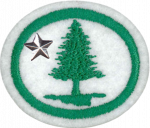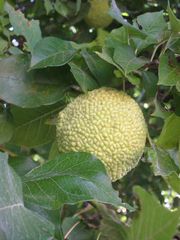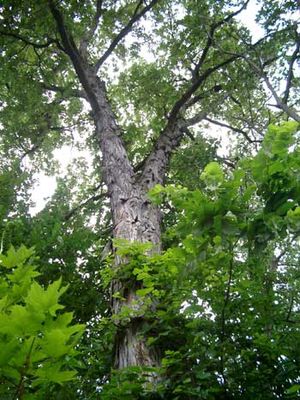Difference between revisions of "AY Honors/Trees - Advanced/Answer Key/es"
(Created page with "{{clear}}") |
(Created page with "{{clear}}") |
||
| Line 216: | Line 216: | ||
{{clear}} | {{clear}} | ||
| − | + | {{clear}} | |
| − | |||
| − | |||
| − | |||
| − | |||
| − | |||
| − | + | {{clear}} | |
| − | |||
| − | |||
;Hackberry: The bark of the hackberry tree is warty. These warts are typically .25 inches (6 mm) in diameter, and arranged in groups on the tree's trunk. | ;Hackberry: The bark of the hackberry tree is warty. These warts are typically .25 inches (6 mm) in diameter, and arranged in groups on the tree's trunk. | ||
Revision as of 03:40, 1 March 2021
| Árboles- Avanzado | ||
|---|---|---|
| Asociación General
|
Destreza: 3 Año de introducción: 1949 |
|
Requisitos
1
Para consejos e instrucciones, véase Árboles.
2
3
3a
3b
3c
3d
3e
3f
The margins of the leaf have large, smooth indentations that do not go all the way to the centerline. (oaks)
3g
3h
3i
3j
3k
3l
4
4a. Describe the advantages in using the Latin or scientific names.
Latin names (such as Quercus alba which is white oak) are useful because they are absolutely unique for each species. Thus, the Latin name can be used in international settings without ambiguity. Sometimes a given species will go by one name on one region, and by another name in another region.
4b. Of what use are the two parts of a scientific name?
The first part of the scientific name is the genus, and the second part is the species. We have already discussed Quercus alba - the white oak, so let's expand on that. There are many, many different species of oak, and they are all in the genus Quercus. All these trees produce acorns, and they are closely related to one another. Grouping them into a common genus recognizes their similarities, while separating them by species recognizes their differences.
5
Angiosperms
- Beech Family
- Beeches, Chestnuts, Chinkapins, and Oaks
- Birch Family
- Alders, Birches, Hornbeams, and Hazelnuts
- Cashew Family
- Smoketree and Sumacs
- Custard-Apple Family
- Pawpaw and Pond apple
- Elm Family
- Elms and Hackberries
- Horsechestnut Family
- Buckeyes and Horsechestnuts
- Laurel Family
- Laurels, Redbay, and Sassafras
- Legume Family
- Acacias, Redbuds, and Locusts
- Magnolia Family
- Magnolias, and Yellow (Tulip) Poplar
- Maple Family
- Maples
- Mulberry Family
- Figs, Mulberries, and Osage Oranges
- Palm Family
- Coconuts, Dates, Palms, and Palmettos
- Rose Family
- Apples, Peaches, Pears, and Plums
- Sycamore Family
- Sycamores
- Walnut Family
- Hickories, and Walnuts
- Willow Family
- Aspens, Poplars, and Willows
6
A leaf is the part of a plant specialized for photosynthesis. For this purpose, a leaf is typically flat and thin, to expose the cells containing chloroplast to light over a broad area, and to allow light to penetrate fully into the tissues. Leaves can store food and water.
7
This is a partial list of trees with opposite leaves. There may be more in your area.
8
8a
8b
8c
8d
8e
Examination of the cross-section of a log will reveal dark wood near the center, and light-colored wood near the bark. The dark wood near the center is heartwood. As a tree increases in age and diameter an inner portion of the sapwood becomes inactive and finally ceases to function, as the cells die. This inert or dead portion is called heartwood.
8f
8g
8h
8i
8j
8k
8l
9
9a
9b
9c
9d
9e
9f
9g
9h
10
By bark
The bark of many trees is easily recognizable, and in some cases, using the bark to identify the tree is easier than using the leaves.
- Hackberry
- The bark of the hackberry tree is warty. These warts are typically .25 inches (6 mm) in diameter, and arranged in groups on the tree's trunk.
- Hornbeam
- The bark of the hornbeam (also known as ironwood) looks distinctively muscular. It is smooth and looks very much like the limb of a muscular human. Indeed it sometimes goes by the name "musclewood" for this very reason.
- Shagbark Hickory
- Mature Shagbarks are easy to recognize because, as their name implies, they have shaggy bark. This character is however only found on mature trees; young specimens have smooth bark.
By buds and twigs
Virginia Tech has a website at http://www.cnr.vt.edu/DENDRO/DENDROLOGY/syllabus/twigkey/location.htm which will aid you in identifying trees by their twigs. The arrangement and structure of buds on a twig are unique to many species, and therefore useful as an identification tool. In some cases, identification by twigs is more accurate than by leaves. The following trees are among the easiest to identify by their twigs:
- Alder
- Maple
- Apple
- Hawthorn
- Black Locust
- Honey Locust
By Characteristic Form
Some trees have a unique shape. If you learn to recognize trees by their shape, it is possible to identify them even from a great distance.
- Elm
- Elm trees are generally vase shaped
- Willow
- Note the dense, thin branches in the top of the tree.
- Lombardy Poplar
- Lombardy Poplars are slender, columnar tree with branches pointed sharply upward.
By Growth Habits
Some trees have preferred habitats. The American Sycamore, for example, tends to grow near plentiful water sources. Because of its distinctive bark, it is usually easier to find creeks by finding the sycamore than it is to find the sycamore by finding a creek.
References
- Categoría: Tiene imagen de insignia
- Adventist Youth Honors Answer Book/Honors/es
- Adventist Youth Honors Answer Book/es
- Adventist Youth Honors Answer Book/Skill Level 3/es
- Categoría: Libro de respuestas de especialidades JA/Especialidades introducidas en 1949
- Adventist Youth Honors Answer Book/General Conference/es
- Adventist Youth Honors Answer Book/Nature/es
- Adventist Youth Honors Answer Book/Nature/Primary/es
- Adventist Youth Honors Answer Book/Stage 0/es
- AY Honors/Prerequisite/Trees/es
- AY Honors/See Also/Trees/es
- Adventist Youth Honors Answer Book






